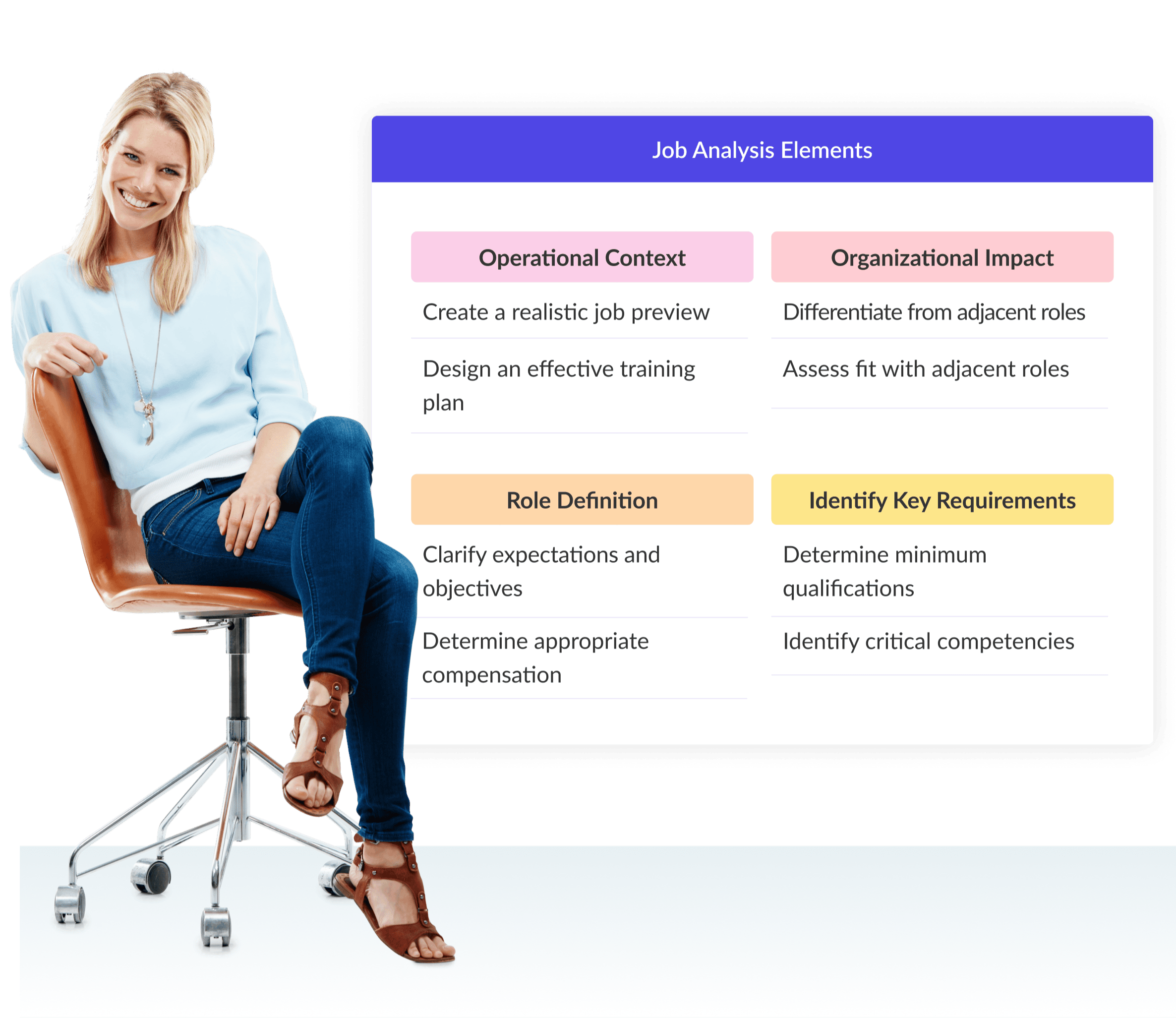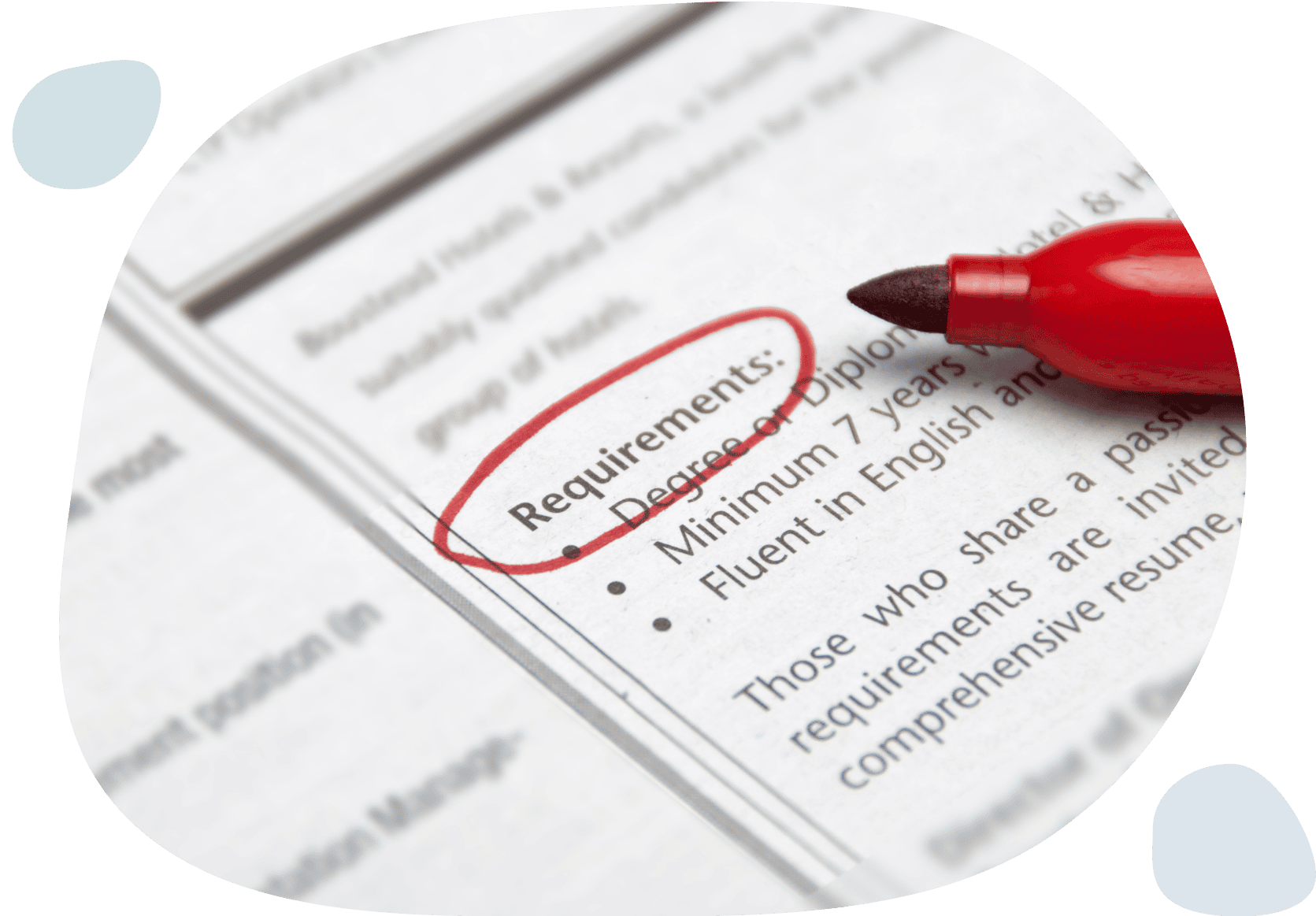
Conduct Great Panel Interviews
Conduct effective panel interviews with expert tips and strategies. Make confident hiring decisions today.

TL;DR: Conducting a Job Analysis
A job analysis involves gathering in-depth details about a job role. The goal is to understand what the work environment is like, what the job requires employees to do, and what competencies they must possess to perform the job effectively.
Here are 5 steps to conduct a job analysis:
Outline the job requirements
Explore the desired outcomes for the role
Find out what training is required on the job
Determine a realistic and fair compensation package
Lastly, continue to evolve the job as things change
A job analysis is a formalized way to collect and analyze information about a job role. For hiring and recruitment purposes, HR professionals use job analysis to accurately capture the activities, competencies, and context of the job to ensure every element of the interview process is job-relevant. The OPM summarizes the function of this process well: “Job analysis is the foundation for all assessment and selection decisions.”
This type of analysis breaks an entire job down into smaller pieces, like tasks, using a systematic method for gathering and synthesizing data. The information collected includes:
What employees do on the job
What competencies are needed to do the job well
The resources that are used to do the job
The job’s environment or conditions
Depending on the method, the process is led by a qualified HR practitioner, job analyst, or consultant who has a clear picture of HR’s strategic objectives.
The analysis data informs a number of different HR functions. In this article, we’ll be focusing on using this data to enable a better interview process.
In hiring, the structured interview process is best organized around a job analysis.
Start conducting structured interviews
Trying to make hiring decisions without having crucial information about the roles at your organization is a bit like trying to bake a cake without knowing what kind of cake it is, or what it’s supposed to taste or look like. You cannot make the right decision without understanding what you’re looking for. Here are four reasons why they are important:

1. Operational context
Having access to more information allows you to stop second-guessing and make more effective decisions. With the full picture of a role, you can confidently do things like provide a realistic job preview during the hiring process and put together an effective training plan.
2. Organizational impact
The more you understand the roles at your organization, the more strategic you can be when making decisions. An analysis can also help you find points of differentiation between similar roles and to better understand how they fit with the positions they interact with.
3. Role definition
Some hiring managers may not understand the full picture of a position they manage, leading to poor hiring decisions. A job analysis can clarify expectations for new employees, validate compensation bands, and better inform hiring managers about the roles they supervise.
4. Identify key requirements
A job analysis defines what competencies a great candidate should bring to the table, the minimum qualifications needed to perform the role, and which competencies are mission-critical, so you stand a better chance of hiring and retaining the right person.
“Job analysis has always been, and will continue to be in the foreseeable future, a valuable informational tool in human resource management.”
- Parbudyal Singh, in an article for Human Resource Management Review.
What kind of information is collected in a job analysis? This data can generally be divided into three categories: activities, competencies, and context.
Activities
What does this role do and look after? What are the basic functions of the job?
Competencies
What competencies are necessary to do the job well?
Context
How would you describe this role’s work environment?
Who and what is involved?
While there are many HR uses for job analysis data, it can be used to improve a structured hiring and recruitment process. Many teams document these activities, competencies and context in more structured frameworks so hiring and performance conversations stay aligned over time. Research by enterprise creative teams shows how map roles, skills and collaboration patterns before hiring or restructuring, to keep job expectations transparent across marketing, design and operations.
What specifications does a candidate need to qualify for a role and what can they learn?
A good analysis can help you answer that. Specifications include education, work experience, and professional qualifications or certifications.
Job seekers don’t want to apply if the job description is unclear. Unfortunately, Burnett’s Staffing said being too vague is the #1 mistake employers make when writing one.
Modern job descriptions are very detailed, going the extra mile to sell candidates on the role and the organization. A job analysis not only informs the job description process, it can also identify key attributes you can use to attract top candidates.
The core competencies identified in the analysis are used to create a clear job description, in addition to the interview guide, and interview questions in a structured process.
Selection assessments are a great way of inviting candidates to demonstrate how they would complete a real task they would encounter in the role. A job analysis reveals what tasks or competencies are most critical to a role, so data can be used to develop assessments that evaluate what is most important. They can also help determine what assessment methods (competency-based or task-based) are most appropriate for a given job.
Outside of hiring, what is this data used for?
Outside of the context of hiring and recruitment, job analysis data can be used to:

There are several formal ways HR teams can conduct a job analysis. When incorporating job analysis as the first step in your structured hiring process, keep in mind that some methods are more helpful than others.
A study in the Academy of Management Journal evaluated several job analysis methods against each other to see what method was most effective for each purpose. It identified the job analysis methods that were best for writing job descriptions and setting job specifications: Threshold Traits Analysis (TTA), Task Inventory (TI), Functional Job Analysis (FJA), and the Job Elements Method. Some other common job analysis processes used in HR functions are Critical Incident Technique (CIT) and Position Analysis Questionnaire (PAQ).
Name of Method
Description
Best use case for hiring
Functional Job Analysis (FJA)
An FJA will help teams to create accurate job descriptions by defining the necessary work activities and responsibilities to outline, and what qualifications are required to perform the job well. This method focuses on specific tasks rather than outcomes (as they can be achieved in numerous ways).
Writing job descriptions
Task Inventory (TI)
A task inventory is a structured list of all the tasks related to a specific job, scoring their frequency, importance, and difficulty. This method is completed collaboratively, as the manager, subject matter experts, and employees in the position work together to complete this list.
Writing job descriptions and job classification
Threshold Traits Analysis (TTA)
TTA is a method for identifying the traits required to perform a job effectively. It uses a collaborative approach where those who know the job role (such as someone with the job title, and their manager) rate the importance, uniqueness, relevance, level, and practicality of 33 traits for the role.
Personnel requirements and job classification
Job Elements Method
A main objective of JEM is to identify workers’ eligibility for a job. This methodology compares applicants’ abilities against the job requirements, focusing on the attributes needed for top job performance.
Personnel requirements
Critical Incident Technique (CIT)
A critical incident is when an action, or actions, contribute to an effective or an ineffective outcome. The CIT is a task analysis technique that helps you identify good and bad behaviors that contribute to critical incidents.
Providing performance reviews and feedback
Position Analysis Questionnaire (PAQ)
A PAQ is the most standardized way of comparing different positions using quantitative and qualitative data. According to HR Guide, the PAQ contains hundreds of job elements that cover five categories: information input, mental processes, work output, relationships with others, and job context. This is based on data from thousands of jobs.
Job classification and job evaluation (used to determine salary)
In a lot of circumstances, it’s useful to use a combination of these methods to get the full picture. The Academy of Management Journal evaluation mentioned above demonstrates that using one method may give you a different response than if you use another.
More typically, HR teams use a variety of approaches to get the best understanding of a job role. Here is an overview of common data collection techniques:
Work Log or Diary
The work diary or log method (also referred to as the daily method) requires an incumbent employee to record all their daily activities for a short period of time. This includes what the task is, the amount of time spent on the task, and the perceived importance or urgency.
Observation
Direct observation is meant to provide a realistic view of the position’s activities and context. A manager, qualified HR practitioner, job analyst, or consultant would watch an employee perform their tasks without getting involved.
Questionnaires
Questionnaires are one of the most affordable and accessible ways to collect data. O*NET has generic, structured questionnaires available for job incumbents or subject matter experts to fill out as “a starting point to collect occupational data”.
Competitive Research
Scope out what competitors and other comparable companies are asking for in terms of job titles and their requirements and duties. Review a variety of other companies to ensure you’re getting an accurate stance on what the most vital and relevant expectations are.
Interview
Doing a job analysis interview involves booking an in-person or video interview where a manager would speak to an employee who currently holds the position or an employee who has held it in the past. Depending on the role, you could also interview people in adjacent positions.
Similar to direct observation, the interviewer would simply be responsible for leading the interview and capturing the employee’s viewpoint. Ideally, you’d interview more than one employee to collect multiple perspectives on a job role and use predetermined questions to standardize your job analysis interview.
Job Performance
In this method, a job analyst would actually perform work activities of the role to understand stressors, contextual factors (physical risks, for example), and scenarios job holders face.
This method provides a first-hand experience of what the job physically and mentally entails, which is more visceral than simply listing things out.
The job performance method is similar to the direct observation method, except in the direct observation method, the person cataloging the job information does not participate at all.
Depending on the job role and industry, there can be several different steps needed to conduct a sufficient job analysis. For a simplified, yet helpful approach, here are the main components that should cover most job types.
The first step is to outline the job role in terms of duties, responsibilities, and expectations. This step helps you develop an accurate job description, though it’s necessary to complete all components beforehand to give candidates the most comprehensive summary of a role.
Best ways to collect information about job requirements
Work Log or Diary
Observation
Interview
Job Performance

Consider the bigger picture of this role – how does this position benefit the organization as a whole? Every job is connected to the success of other roles. Outlining what you hope to get out of the position is as important as what you put into it. This step, along with the previous step, are the most important to help you build an effective interview plan and fairly evaluate candidates based on your definition of success.
Top methods to learn about desired role outcomes
Questionnaires
Interview
Job Performance
Learn what tools and training are required for a new hire to achieve both short and long-term success. Discover what your organization needs to provide them with to help them truly master their role. For each training component, consider who will need to train them, how long it will take, and how that will impact their workload.
Most effective ways to discover the required training
Work Log or Diary
Questionnaires
Interview
It can be hard to determine a fair salary – there are a lot of variables such as the experience of a candidate, and how lucrative an offer needs to be to fill the position successfully. By following the steps involved in a job analysis, you should be able to summarize key job details needed for determining a fair compensation package.
Best approaches to determine an ideal compensation
Competitive Research
Internal Comparisons
A job analysis is not a one-and-done activity. As time goes on, the expectations and duties for a position change. This can be due to factors such as the company evolving, or a transition in the industry or the economy as a whole.
Some jobs evolve more frequently than others, especially in the case of jobs that involve any kind of technology. In these cases, you’ll want to consider refreshing your analysis annually. However, if a position is relatively unchanging, then you’ll only need to review and refresh the analysis as needed.
An up-to-date analysis of every position means job descriptions, expectations, and compensation are kept relative. Ultimately, with your finger on the pulse, you’ll keep attracting candidates who are the right fit for the role.
When creating a job analysis, it’s best practice to do so for all available jobs, not solely for one job – there could be ways to optimize roles. For example, you may notice an overlap in responsibilities, or another role would be better suited for a task.

A job analysis is the process of gathering information about the competencies a candidate should have, and everything the candidate needs to perform, in order to do a job effectively.
A job description is a written statement describing a job opportunity to a job seeker. They include the job title, desired competencies, required certifications, working conditions, and tasks and responsibilities.
Job descriptions live on job board sites because they are intended for an external audience, whereas a job analysis is primarily conducted and created for internal use.
Here’s a list of some examples:

E-BOOK
The Modern Guide to Structured Interviewing
Get your free copy of VidCruiter’s comprehensive white paper about structured interviewing. This practical guide:
By providing email address, you agree to receive
updates from VidCruiter.
Read our
Privacy Policy
Modernize your hiring process with expert insights and advice.